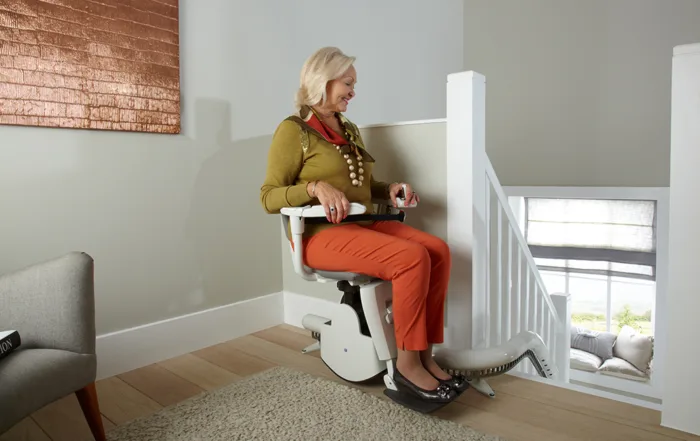Staying at Home with a Stairlift: A Practical Alternative to Moving
Categories:
Blog , Stairlifts
Date Posted:
August 5, 2025

As we age or face mobility challenges, getting up and down the stairs can become a daily struggle. For many people in the UK, this can lead to a difficult decision: should you stay in your own home or consider moving to a retirement apartment or care home? While both options have their place, an increasing number of people are choosing to remain in their familiar surroundings with the help of mobility aids such as stairlifts and mobility aids.
The desire to “age in place” is stronger than ever and thankfully, modern mobility equipment makes it more achievable and affordable than many people realise.
The Benefits of Staying at Home
Remaining in your own home offers emotional, practical and financial benefits. Familiar surroundings, cherished routines, and proximity to neighbours and local amenities all contribute to a better sense of well-being and independence. With a few key adaptations, most homes can be made much safer and more accessible.
Installing a stairlift allows you to continue using your entire home without the risk of falling. Additional equipment, such as hand rails, bath lifts and walking aids can provide further support where needed, and all without the upheaval of moving.
The Cost of a Stairlift vs Moving
Financially, installing a stairlift is considerably cheaper than moving into retirement housing or a care facility. As well as the costs involved with moving including solicitor and estate agent fees and movers, retirement living can mean monthly service charges and ground rent, and care home fees being even more costly still.
For many people, adapting their home with a stairlift and other aids is not just the more affordable choice, but the more sustainable one too.
Staying at Home vs Moving
The Benefits of Remaining in Your Own Home:
- Remain in a familiar and comfortable environment
- Maintain independence and control over daily routines
- Lower overall cost with one-time adaptation expenses
- No need to downsize or part with cherished possessions
- Avoid the stress and disruption of moving
Considerations When Remaining at Home:
- May require modifications such as stairlifts, ramps or bathroom adaptations
- You may still need home help or carers
- Ongoing maintenance and upkeep of the property
The Benefits of Retirement Living or Care Homes:
- On-site support and carers available
- No property maintenance responsibilities
- Social activities and community living
- Designed with accessibility in mind
Potential Drawbacks of Retirement Living or Residential Care:
- High upfront and ongoing costs
- Less personal space and privacy
- Can be emotionally difficult to leave your home
- Potential waiting lists or limited local availability
Making the Right Choice for You
Ultimately, the decision to stay at home or move into supported housing is a personal one, shaped by your health, lifestyle, finances and family support. But it’s important to understand that staying in your home is not only possible, it’s often the more empowering option.
With the right mobility equipment, you can continue enjoying the comfort and security of home for many years to come. And at a fraction of the cost of alternative care options, it’s a decision that can make both emotional and financial sense.
If you’re considering adapting your home for improved mobility, EMS Lifts Ltd offers a complete turn-key solution. From stairlifts to ramps, hoists and homelifts, our team handles every aspect of installation and aftercare to help you live safely and comfortably in your own space.






